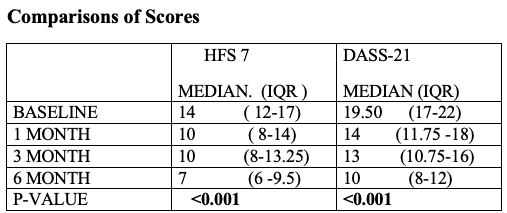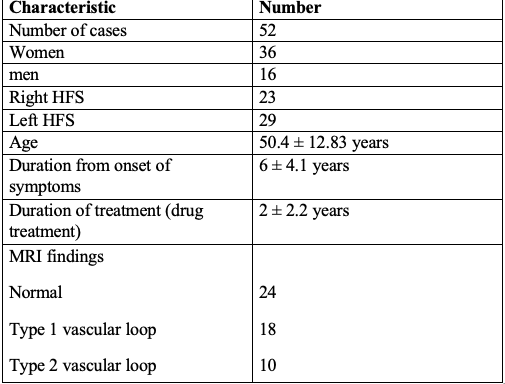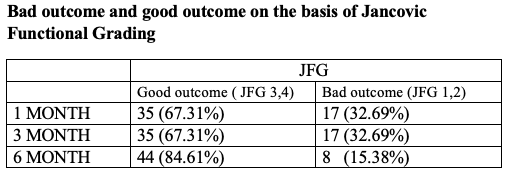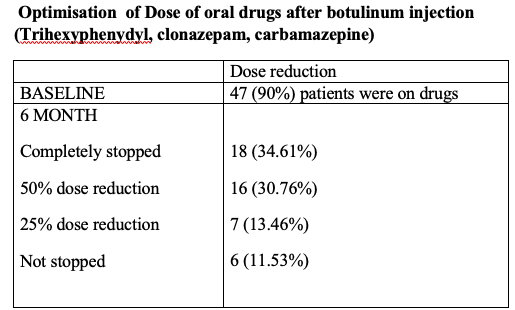Category: Other
Objective: To study the predictors of Good and Bad outcome and the impact on quality of life of patients with HFS following Botulinum toxin treatment.
Background: HFS is a progressive,involuntary,irregular,clonic or tonic movements of the muscles innervated by the facial nerve1. HFS causing significant psychosocial distress. BOTULINUM TOXIN A is the currently preferred symptomatic treatment for primary HFS.Because HFS rarely remits spontaneously, most patients need to continue treatment for many years so the long-term efficacy and safety of BTX are crucial considerations.3
Method: The study was conducted in Department of Neurology in King George’s Medical University, Lucknow. All patients with HFS presenting to the Neurology OPD were evaluated for the study.This Prospective Cohort study, Included the patient of age>18 years,clinically diagnosed as primary HFS and botulinum naive patients.Excluded all the secondary HFS and HFS mimickers.Compared the outcomes with the help of HFS 7 SCALES for Quality of life assessment,JFG Scale for improvement,and DASS 21 scale for psychiatric assessment.Scores were compared at baseline and at 1,3 and 6 months post-treatment using statistical tests such as Friedman Test and Wilcoxon Signed Ranks Test.SPSS for Windows is used for statistical analyses and P value.
Results: The study sample comprised 52 patients with primary HFS, including 36 women and 16 men, with age of 50.4 ± 12.8 years.Right and Left HFS was present in 23 and 29 patients respectively.The latency between the onset of symptoms and the correct diagnosis of HFS was 4.5 ± 4.2 years.Received drug treatment for 2 ± 2.2 years. Patients presented with co-morbidities such as DM, hypothyroidism, CAD, and hypertension,and hypertension being the most common (30%).Of the total 52 patients, 17 had a poor outcome at the 1-month follow-up,prompting dose adjustments for subsequent visits (at the 3 month).After repeated injection,the outcome improved. At the 6-month follow-up, only 8 patients had a poor outcome,It was found that they had type 2 vascular loops and hypertension, and they were older than the patients who had good outcomes. There was no significant correlation between the outcomes and gender,site of the HFS,duration of disease.
Conclusion: Mostly Primary HFS patients are good responders for Botulinum treatment but who have long standing hypertension and type 2 loops were poor responders.
Table no 2
Table no 1
Table no 3
Table no 4
References: 1. Wang A, Jankovic J. Hemifacial spasm: clinical findings and treatment. Muscle Nerve. 1998;21:1740–1747.
2 .Wilkins RH. Hemifacial spasm: a review. Surg Neurol. 1991;36:251– 277
3. Li, Y.; Huang, Y.; Ding, Q.; Gu, Z.; Pan, X. Evaluation of concentrations of botulinum toxin A for the treatment of hemifacial
spasm: A randomized double-blind crossover trial. Genet. Mol. Res. 2015, 14, 1136–1144.
To cite this abstract in AMA style:
S. Jain, S. Pandey, RK. Garg, HS. Malhotra, I. Rizvi. Predictors of Response to Botulinum Toxin Treatment in Patients With Hemifacial Spasm:A Prospective Study [abstract]. Mov Disord. 2024; 39 (suppl 1). https://www.mdsabstracts.org/abstract/predictors-of-response-to-botulinum-toxin-treatment-in-patients-with-hemifacial-spasma-prospective-study/. Accessed April 3, 2025.« Back to 2024 International Congress
MDS Abstracts - https://www.mdsabstracts.org/abstract/predictors-of-response-to-botulinum-toxin-treatment-in-patients-with-hemifacial-spasma-prospective-study/




